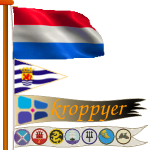Login
Support Sailonline
If you haven't already - join the SAILONLINE YACHT CLUB!
Please also consider making a donation - all amounts are greatly appreciated!
Board
»
General Discussion
»
SOL maps Datum & Interpolations.
|
Posted by JB  |
|
|
Viva all,
Two questions for the STC: 1 - What is the SOL maps Datum? 2 - What is/are the algorithm/s used for (TWS; TWD) interpolation? Thank you STC. Sail Fair. |
|
|
Posted by A2  |
|
|
SOL uses data from GSHHG (Global Self-consistent, Hierarchical, High-resolution Geography Database)
http://en.wikipedia.org/wiki/GSHHG Data for each resolution is formatted to tiles which are visible in the game. The tiles are compressed files with XML-formatted polygons (list of lat/lon coordinates) of the shorelines of islands and continents. None so blind |
|
|
Posted by kroppyer  |
|
|
sol uses h and i resolutions of GSHHG, and c and l resolutions are used in the client only for when you are zoomed out and don't need to see all details.
Interpolation: this is what I found by measuring and fitting: u/v interpolation (not TWS/TWD) over space: linear over time: I found this a close match (but not exact): previous+(next-previous)*(0.5+0.5*cos(t/(2pi))) with 0<=t<=1, previous the value for t=0 and next the value for t=1.
(end quote) |
|
|
Posted by JB  |
|
|
Viva “A2”, Huib and Jakob,
Thank you for your quick and detailed replies. Following now more comments. Sail Fair. |
|
|
Posted by JB  |
|
|
Viva Huib
From what I understood the Wind vector field is divided in two vector components along orthogonal directions: North -South (“u” Wind vector component) and East - West (“v” Wind vector component) - see also included file. Confirm pls if your approximation formula for interpolation over time (between time “t0” and time “t1”, with t1 > t0) is: u1 = u1 + ( u1 - u0 ) x ( 1/2 + cos ( t/2PI )/2 ). v1 = v1 + ( v1 - v0 ) x ( 1/2 + cos ( t/2PI )/2 ). Did you managed to find a sigma (STD) for your (time, distance) interpolation results? Thank you Huib. Sail Fair. |
|
|
Posted by JB  |
|
|
Viva Jakob,
Very interesting this subject, to say the least. I’m one of the SOLers being puzzled for a long time, first, with the process for the SOL Wind interpolation process. “How it’s done?” Secondly, the ruthless lack of consistency between routing software results and GRIB data in the low wind range, i.e., aprox. 0 < TWS < 6,00 - 8,00 Kts, independently of the GRIB given TWA, normally obtaining over rated BS. For the last issue I strongly believe that that are two main causes for this discrepancies: 1 - Different Wind interpolation processes (routing software vs. SOL one); 2 - Time step calculation used on routing, IMHO the second factor is the preponderant one. If we think that, for instance, the minimum step calculation for qTVlm is 5 minutes, and if we have an 8º/minute induced Wind veering, difficulty you reach a 5 minute distance in the routing software with the calculated BS, not to say TWA. The implications are obvious. But now, it’s time for understanding the first factor: Wind interpolations. So, for the”distance” interpolation SOL uses bi-linear interpolation. For the “time” one you mentioned “simple shape functions”, Can you pls detail more what are those “shape functions (linear, polynomial, 3D mesh, …)? Thank you Jakob. --- Last Edited by JB at 2015-04-17 11:09:16 --- Sail Fair. |
|
|
Posted by kroppyer  |
|
|
I quoted Jakob from a post from 2010, I don't expect him to elaborate on that soon.
The formulas show you understood what I meant. Use t=t'/(t1-t0)-t0 to "normalise" t to [0,1]. I have no real sigma, but from what I remember it's around 2% at t=0.25/t=0.75, it's exact at t=0,0.5,1 It's weird to use a cos for this purpose, it's relatively heavy to calculate and far to precise for something that doesn't need geometry. Sol probably uses some 3rd to 5th order polynomial approximation that is faster to calculate, but slightly different from cos(). |
Please login to post a reply.
Races
Next Race: 00d 00h 00m
Current Races:
Aeolian Cruise 2025

This is the final race of the ARCH 2025 series and your last chance to improve your ranking. It promises to be an exciting 210nm slalom through the beautiful landscapes of the Aeolian Islands. Our Moody S38's will take off from Tropea and sail west between successive islands to reach the finish line in the Gulf of Palermo.
Fair Winds.
Race #1991
INFO from brainaid.de
Moody S38 PARTICULARS
WX Updates:
0430 / 1030 / 1630 / 2230
Ranking:
ARQ4 - ARCH - SUPSOL - SYC
Race starts: Dec 15th 17:00 Registration will open soon
GO TO RACE
Chatham Island TIMED Chase 2025

Race #1990
INFOby brainaid.de
Farr 38 Particulars
WX Updates:
0430 / 1030 / 1630 / 2230
Ranking:
TRQ4 - TRCH - SUPSOL - SYC
RACE CLOSE: Saturday,
27 December at 23:00 UTC
Race starts: Dec 14th 12:00 Registration will open soon
GO TO RACE
Great Bear Ice Race 2025
You can fly to Great Bear Lake Airport, but if the ice is good, instead hire a pick-up truck, load your disassembled DN into the cargo bed and drive, first following the McKenzie River north, and then straight across the lake to the start of our final Ice Boat series race of roughly 100nm in length. The Airport authorities have agreed to leave all lights on, so you should just about be able to see where you are going as you zing and rumble, PL-free over the ice!
Race #1853
INFOby brainaid.de
DN PARTICULARS
WX Updates:
0430 / 1030 / 1630 / 2230
Ranking: DN - SYC
RACE CLOSE: Friday,
December 12 at 2300 UTC.
Race starts: Dec 07th 09:00 Registration Closed
GO TO RACE
Christmas to Christmas Island 2025

PRIZE: SMPF
Race #1967
INFO by brainaid.de
Maxi Trimaran PARTICULARS
WX Updates:
0430 / 1030 / 1630 / 2230
Ranking: OCQ4 - OCCH - SUPSOL - SYC
Race starts: Dec 01st 11:00 Registration Closed
GO TO RACE
SYC Ranking
Series
- SYC ranking
- 2025 TS
- 2025 TRQ4
- 2025 TRQ3
- 2025 TRQ2
- 2025 TRQ1
- 2025 TRCH
- 2025 TD
- 2025 SuperSOLer
- 2025 SSANZ
- 2025 SPRCH
- 2025 SPQ4
- 2025 SPQ3
- 2025 SPQ2
- 2025 SPQ1
- 2025 SHE
- 2025 SBB
- 2025 RWW
- 2025 RMI
- 2025 RED
- 2025 OCQ4
- 2025 OCQ3
- 2025 OCQ2
- 2025 OCQ1
- 2025 OCCH
- 2025 NT
- 2025 LOOR
- 2025 DN
- 2025 B2B
- 2025 ARQ4
- 2025 ARQ3
- 2025 ARQ2
- 2025 ARQ1
- 2025 ARCH
- 2025 ABS
- 2024 TS
- 2024 TRQ4
- 2024 TRQ3
- 2024 TRQ2
- 2024 TRQ1
- 2024 TRCH
- 2024 TD
- 2024 SVF
- 2024 SUPerSOLer
- 2024 SSANZ
- 2024 SPRQ4
- 2024 SPRQ3
- 2024 SPRQ2
- 2024 SPRQ1
- 2024 SPRCH
- 2024 SHE
- 2024 RTW
- 2024 RMS
- 2024 OCQ4
- 2024 OCQ3
- 2024 OCQ2
- 2024 OCQ1
- 2024 OCCH
- 2024 LOOR
- 2024 HILAT
- 2024 GWT
- 2024 DN
- 2024 CRW
- 2024 B2B
- 2024 ARQ4
- 2024 ARQ3
- 2024 ARQ2
- 2024 ARQ1
- 2024 ARCH
- 2023 TS
- 2023 TRQ4
- 2023 TRQ3
- 2023 TRQ2
- 2023 TRQ1
- 2023 TRCH
- 2023 TD
- 2023 SVS
- 2023 SUPerSOLer
- 2023 SSANZ
- 2023 SPRQ4
- 2023 SPRQ3
- 2023 SPRQ2
- 2023 SPRQ1
- 2023 SPRCH
- 2023 SHE
- 2023 RTW
- 2023 RNI
- 2023 RMS
- 2023 PIC
- 2023 OCQ4
- 2023 OCQ3
- 2023 OCQ2
- 2023 OCQ1
- 2023 OCCH
- 2023 LOOR
- 2023 DN
- 2023 ARQ4
- 2023 ARQ3
- 2023 ARQ2
- 2023 ARQ1
- 2023 ARCH
- 2022 TRQ4
- 2022 TRQ3
- 2022 TRQ2
- 2022 TRQ1
- 2022 TRCH
- 2022 TD
- 2022 Tall Ships
- 2022 SUPerSOLer
- 2022 SSANZ
- 2022 SSA
- 2022 SPRQ4
- 2022 SPRQ3
- 2022 SPRQ2
- 2022 SPRQ1
- 2022 SPRCH
- 2022 SHE
- 2022 OCQ4
- 2022 OCQ3
- 2022 OCQ2
- 2022 OCQ1
- 2022 OCCH
- 2022 NTR
- 2022 LOOR
- 2022 CTR
- 2022 ARQ4
- 2022 ARQ3
- 2022 ARQ2
- 2022 ARQ1
- 2022 ARCH
- 2021 TRQ4
- 2021 TRQ3
- 2021 TRQ2
- 2021 TRQ1
- 2021 TRCH
- 2021 TD
- 2021 Tall Ships
- 2021 SYCQ4
- 2021 SYCQ3
- 2021 SYCQ2
- 2021 SYCQ1
- 2021 SYCCH
- 2021 SUPerSOLer
- 2021 SSANZ
- 2021 SPRQ4
- 2021 SPRQ3
- 2021 SPRQ2
- 2021 SPRQ1
- 2021 SPRCH
- 2021 Shetland
- 2021 PAC6
- 2021 OCQ4
- 2021 OCQ3
- 2021 OCQ2
- 2021 OCQ1
- 2021 OCCH
- 2021 ESRW
- 2020 TSE
- 2020 TSA
- 2020 TRQ4
- 2020 TRQ4
- 2020 TRQ3
- 2020 TRQ2
- 2020 TRQ1
- 2020 TRCH
- 2020 Tasman Double
- 2020 SYCQ4
- 2020 SYCQ3
- 2020 SYCQ2
- 2020 SYCQ1
- 2020 SYCCH
- 2020 SUPerSOLer
- 2020 SSANZ
- 2020 SRQ4
- 2020 SRQ3
- 2020 SRQ2
- 2020 SRQ1
- 2020 SPRCH
- 2020 Shetland
- 2020 RTW
- 2020 RNI
- 2020 Odyssey
- 2020 OCQ4
- 2020 OCQ3
- 2020 OCQ2
- 2020 OCQ1
- 2020 OCCH
- 2020 A3
- 2019 TRQ4
- 2019 TRQ3
- 2019 TRQ2
- 2019 TRQ1
- 2019 TRCH
- 2019 Tasman Double
- 2019 Tall Ships
- 2019 SYCQ4
- 2019 SYCQ3
- 2019 SYCQ2
- 2019 SYCQ1
- 2019 SYCCH
- 2019 SUPerSOLer
- 2019 SSANZ
- 2019 SRQ4
- 2019 SRQ3
- 2019 SRQ2
- 2019 SRQ1
- 2019 SPRCH
- 2019 Shetland
- 2019 Round New Zealand
- 2019 OCQ4
- 2019 OCQ3
- 2019 OCQ2
- 2019 OCQ1
- 2019 OCCH
- 2018 TRQ4
- 2018 TRQ3
- 2018 TRQ2
- 2018 TRQ1
- 2018 TRCH
- 2018 Tasman Double
- 2018 Tall Ships
- 2018 SUPSOL
- 2018 SSANZ Triple
- 2018 SRQ4
- 2018 SRQ3
- 2018 SRQ2
- 2018 SRQ1
- 2018 SPRCH
- 2018 Shetland
- 2018 Shackleton Challenge
- 2018 OCQ4
- 2018 OCQ3
- 2018 OCQ2
- 2018 OCQ1
- 2018 OCCH
- 2018 40CH
- 2017 TS RDV
- 2017 TRQ4
- 2017 TRQ3
- 2017 TRQ2
- 2017 TRQ1
- 2017 TRCH
- 2017 Tasman Double
- 2017 Tall Ships
- 2017 SWR
- 2017 SUPSOL
- 2017 SSANZ Triple
- 2017 SSANZ RNI
- 2017 SPRR3
- 2017 SPRR2
- 2017 SPRR1
- 2017 SPRCH
- 2017 Red Dot
- 2017 OCQ4
- 2017 OCQ3
- 2017 OCQ2
- 2017 OCQ1
- 2017 OCCH
- 2017 40CQ3&4
- 2017 40CQ1&2
- 2016 TRQ4
- 2016 TRQ3
- 2016 TRQ2
- 2016 TRQ1
- 2016 TRCH
- 2016 Tasman Double
- 2016 Tall Ships
- 2016 SUPSOL
- 2016 SSANZ Triple
- 2016 SRQ4
- 2016 SRQ3
- 2016 SRQ2
- 2016 SRQ1
- 2016 SPRCH
- 2016 RTWR
- 2016 OCQ4
- 2016 OCQ3
- 2016 OCQ2
- 2016 OCQ1
- 2016 OCCH
- 2016 Corporate Open Gold
- 2016 A3
- 2015 TRQ4
- 2015 TRQ3
- 2015 TRQ2
- 2015 TRQ1
- 2015 TRCH
- 2015 Tasman Double
- 2015 Tall Ships
- 2015 SYQ4
- 2015 SYQ3
- 2015 SYQ2
- 2015 SYQ1
- 2015 SYCCH
- 2015 SUPSOL
- 2015 SSANZ Triple
- 2015 SRQ4
- 2015 SRQ3
- 2015 SRQ2
- 2015 SRQ1
- 2015 SPRCH
- 2015 OCQ4
- 2015 OCQ3
- 2015 OCQ2
- 2015 OCQ1
- 2015 OCCH
- 2015 Aegean Rally
- 2014 Timed Races Championship
- 2014 Tasman Double
- 2014 Tall Ships
- 2014 SYC Championship
- 2014 SSANZ Trio
- 2014 SSANZ RNI
- 2014 Sprints Championship
- 2014 Scandinavian Tour
- 2014 Round The World Race
- 2014 Ocean Championship
- 2014-2015 Sailonline World Race
- 2013 Tall Ships
- 2013 SYC Championship
- 2013 SSANZ B&G Simrad
- 2013 Capt Anderson
- 2012 W Australia Regatta
- 2012 Tall Ships
- 2012 SSANZ B&G Simrad
- 2012 RNZ Two Handed
- 2012 Global Challenge
- 2012 Ecker Cup
- 2012 Black Sea
- 2012 A3
- 2011 Vancouver Island
- 2011 Tasman Double
- 2011 SSANZ B&G Simrad
- 2011 SOL Global Challenge
- 2011 SJORA Series
- 2011 Scandinavian Tour
- 2011 Round North Island
- 2011 Asian Sprints
- 2011-2012 SOL World Race
- 2010 Tasman Double
- 2010 Ouzo Rally
- 2010 Iberian Tour
- 2010 Auckland Regional
- 2009 French SOLo
- 2009 Bosphore - Bretagne
- 2008 SYCC
- 2008 -2013 SYC Week Race Championship
- 2008 -2013 SYC Week-End Race Championship
- 2008 -2013 SYC Ocean Race Championship
- 2008-2009 Sailonline Ocean Race
- 2004 LOOR
Mobile Client
SYC members have the benefit of access to our mobile/lightweight web client!

